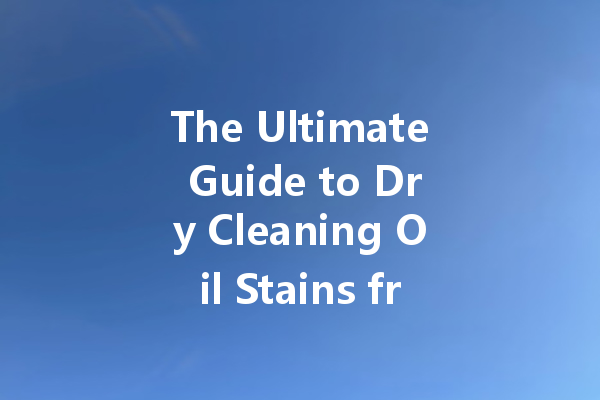Oil stains on clothing can be frustrating, especially when they seem to stubbornly persist despite your best efforts. However, fear not! This guide will walk you through effective methods for removing oil stains using dry cleaning techniques. By understanding the science behind dry cleaning and following these tips, you can restore your favorite garments to their former glory.
Understanding Oil Stains
The Nature of Oil Stains
Oil stains are caused by substances such as cooking oil, motor oil, or grease. These are often difficult to remove because oil does not easily mix with water, making traditional washing techniques less effective. Understanding the molecular structure of oils helps in choosing the right cleaning agent for the job.
Why Choose Dry Cleaning?
Dry cleaning utilizes special solvents instead of water to remove stains, making it particularly effective for oil-based stains. The solvents dissolve the oil, lifting it away from the fabric without damaging it. This is especially beneficial for delicate fabrics that could be harmed by aggressive washing methods.
Choosing the Right Dry Cleaning Agent
Types of Dry Cleaning Solvents
There are various dry cleaning solvents on the market, each with its benefits. The most common include perchloroethylene, hydrocarbon solvents, and environmentally friendly options like liquid CO2-based cleaners. Understanding which solvent works best for your type of oil stain can significantly enhance removal effectiveness.
Testing Solvents
Before applying any dry cleaning agent, it is crucial to test the solvent on a small, inconspicuous area of the fabric. This ensures that the solvent will not cause any damage or discoloration to your clothes.
Preparing for Oil Stain Removal
Gathering Your Supplies
To tackle oil stains effectively, you will need:
Blotting the Stain

Before applying any cleaning agents, gently blot the stain with a clean cloth or paper towel. This will help absorb excess oil and prevent it from spreading. Avoid rubbing, as this can drive the oil deeper into the fabric fibers.
Applying the Dry Cleaning Agent
Proper Application Techniques
Once you’ve blotted the stain, apply a few drops of your dry cleaning solvent directly onto the oil stain. Allow the solvent to penetrate the stain for a few minutes. For larger stains, you may need to apply the solvent to the surrounding area as well.
Gentle Agitation
Using a soft brush or cloth, gently agitate the fabric around the stain. This helps lift the oil from the fibers. Be careful not to scrub too harshly, as this can damage the fabric.
Final Steps
Rinsing and Drying
After treating the stain, rinse the fabric with cool water to remove any remaining solvent. For delicate items, it is best to take them to a professional dry cleaner. If the fabric is durable, you can also hang it to dry, away from direct sunlight.
Inspecting the Stain
Once the garment is dry, inspect the area where the stain was located. If the stain persists, repeat the treatment. Sometimes, oil stains require multiple treatments for complete removal.
Preventing Oil Stains in the Future
Tips for Stain Prevention
To minimize the chances of oil stains, consider these preventative measures:
Conclusion
Properly addressing oil stains using dry cleaning techniques can save your favorite garments from permanent damage. By understanding the nature of oil stains, choosing the right cleaning solvent, and applying the appropriate techniques, you can effectively remove oil stains and keep your clothes looking fresh and new. With these tips in mind, you are now equipped to tackle any oil stain challenge that comes your way!
